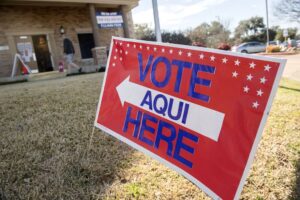Whether the Ballot You Mail Is Counted May Depend on Where You Vote was originally published by ProPublica
ProPublica is a Pulitzer Prize-winning investigative newsroom. Sign up for The Big Story newsletter to receive stories like this one in your inbox.
All vote by mail systems are not created equal. In Wisconsin, a vote cast in one town would have been rejected in another. In Florida, young voters’ ballots are most likely to be tossed.
The April 6 guidance from the U.S. Supreme Court seemed final: Election officials in Wisconsin should only count absentee ballots postmarked on or before the next day’s voting. Then, in the days after the chaotic primary, thousands of ballots poured in with missing or illegible postmarks — an issue the court had not directly addressed. Throwing up its hands, the Wisconsin Elections Commission left it to local officials to decide if ballots had been mailed on time.
The result was a troubling disparity. Janesville, longtime home of former Republican U.S. House Speaker Paul Ryan, received 65 ballots without postmarks after primary day, but before an April 13 deadline. “Consistent with the order from the U.S. Supreme Court,” Janesville officials rejected them all, according to City Clerk David Godek.
In the village of Cambridge, outside Madison, Barbara Goeckner counted all five such ballots. After talking with postal supervisors, the deputy clerk said, she took into consideration that the U.S. Postal Service had reported widespread delays and delivery problems.
“You had 1,854 municipal clerks each determining whether to count or not count,” Goeckner said. “Personally, I believe every vote should count.”
Voting by mail has become a partisan flashpoint during the coronavirus outbreak, with Democrats pushing to expand it and President Donald Trump claiming, without evidence, that mail-in voting is “corrupt.” But, as Wisconsin illustrates, the impact of vote by mail depends in part on how it is implemented.
Policies regarding postmark requirements, verifications of signatures and other ballot rules vary from one state or county to the next. In some states, a mailed ballot that would be accepted in one county or town may be discarded in another, potentially disenfranchising individuals or groups and undermining the constitutional principle of equal voting rights. If the pandemic persists, and November’s presidential election is conducted largely by mail, such inconsistencies could tip the outcome in swing states like Wisconsin.
The Wisconsin Elections Commission “tried to give clear guidance,” spokesperson Reid Magney said. “The decisions came down to individual boards of canvassers in 1,850 municipal offices looking at these things and making determinations.”
Magney said the state did not track how many ballots missing postmarks were accepted or rejected. “We know people are hungry for this data,” Magney said.
Five states — Colorado, Hawaii, Oregon, Washington and Utah — currently run all-mail elections. Since the coronavirus outbreak, several states, including Virginia and Alabama, have expanded the ranks of voters who can request absentee ballots. But policymakers in at least half a dozen states — Arizona, Florida, Nevada, New Mexico, Georgia and Texas — are clashing about how and whether to broaden vote by mail. Their disputes cast doubt about whether states can make a smooth and equitable shift from in-person to mail-in ballots by November.
“I don’t see vote by mail as a panacea,” said Charles Stewart, a professor of political science at Massachusetts Institute of Technology. “The most successful cases have been states that have been deliberate and have organically grown into it.”
Once seen as an uncontroversial option for voters who couldn’t make it to the polls, vote by mail has become increasingly politicized in the battle over the size and shape of turnout. After Georgia’s secretary of state said he would mail forms to all voters to request absentee ballots for its presidential primary in March, the speaker of the state’s House of Representatives, also a Republican, criticized the move as “extremely devastating to Republicans and conservatives. … This will certainly drive up turnout.” (He later walked back his statement, saying he was concerned that voting by mail would lead to fraud.) Georgia has delayed its primary until June 9.
In New Mexico, the state Supreme Court this month blocked a plan by state and county election officials to send all voters a mail-in ballot for the June primary. Texas Democrats sued state and county election officials, including the Republican governor, this month in federal court to expand vote by mail. “Texas has an extensive history of disenfranchising voters and in this moment of national crisis, it appears poised to do so again,” the lawsuit alleges.
The Wisconsin debacle reminded some experts of hanging chads and the contested 2000 presidential election in Florida. “This was the Bush v. Gore problem, where lots of peoples’ ballots were not counted as intended,” said Wendy Weiser, director of the Democracy Program at the Brennan Center for Justice at New York University School of Law. “Ideally we would have a lot more uniformity in which votes count to maximize the counting of valid ballots.”
When ballots are rejected, the ostensible reason is usually logistical. The ballots arrive too late. There’s confusion over postmarks. A signature is missing, or it doesn’t match signatures on file in an election office.
Yet vote by mail rejection rates vary widely among states. (It’s tricky even to compare the data, since states have different rules and rely to different extents on vote by mail.) Washington, which runs an all-mail voting system and is considered a leader in the practice, rejected 0.9% of mail ballots in 2016, the highest rate in the nation, according to the MIT’s Election Performance Index. Wisconsin, for its part, rejected the lowest percentage of mail ballots in 2016 – 0.0095%.
New research suggests certain groups may be disproportionately hurt by ballot rejections. In Florida’s 2018 election, younger voters, those with disabilities and minority voters were far more likely to have their vote by mail ballots discarded, according to research published last week by political scientists at Dartmouth College and the University of Florida.
It’s not clear exactly how this effect takes place. Mailed-in ballots don’t indicate a voter’s age or race. Yet, across every county in Florida, younger voters were significantly more likely to have their ballots rejected, according to the researchers. The researchers examined the 2.6 million vote by mail ballots cast in Florida in 2018, of which 1.2% were rejected. Of 18- to 21-year-olds in the state, 5.4% had their mail ballots rejected, more than eight times the rate of those over 65. Voters aged 18 to 29 comprised 2.1% of all mailed-in ballots, but 9.2% of all rejected mail ballots.
The paper’s authors contend that young voters’ ballots may be more likely to be tossed because their signatures tend to change more than those of older voters. Also, some voters’ names may be more complicated and harder to check. But neither of these factors fully explains the discrepancies.
There was great variability in rejection rates not just between groups but also between counties, even those with similar demographics, reflecting the significant leeway of local officials to decide whose vote gets counted. Dan Smith, a political science professor at the University of Florida and one of the paper’s authors, said that the differences could be driven by intentional or unintentional bias. “What is really persistent and pernicious about this finding is how disenfranchised young voters are when casting ballots by mail,” he said.
If you vote by mail, you must attest that it is your ballot by signing an affidavit on the envelope. The election office then compares that signature to one of yours already on file. Ten states, including Wisconsin, Virginia and North Carolina, also generally require witness or notary signatures, which are harder to obtain in a lockdown.
The best systems, voting experts say, have software to identify potential mismatches and a bipartisan group of signature reviewers for each flagged ballot. But policies for addressing signature problems — and the time given to voters to resolve them — differ from one state or county to the next, prompting a wave of lawsuits across the country.
Voting rights advocates say that many local election administrators aren’t properly trained to suss out problems with signatures. “Coming into the 2020 cycle, we were already pretty concerned about vote by mail in general,” said Jonathan Diaz, counsel for voting rights at the Campaign Legal Center, a Washington D.C.-based nonprofit. “In many states these assessments are being made by poll workers who may have had some kind of signature training, but likely not.”
In 2016, in response to a lawsuit brought by Democrats, a federal judge criticized Florida’s procedures, calling the state’s system “a crazy quilt of conflicting and diverging procedures” for comparing signatures. “The state of Florida has categorically disenfranchised thousands of voters arguably for no reason other than they have poor handwriting or their handwriting has changed over time,” the judge concluded. In response, Florida passed a bill intended to standardize the process by which voters can contest ballot signature problems.
An April review of California’s signature verification procedures by Stanford’s University’s Law and Policy Lab found “limited statewide uniform criteria or standards for signature verification, and what ‘counts’ as a matching signature varies enormously from county to county.”
In Arizona, where some 80% of votes are cast by mail, a partisan fight over signature-matching issues helped delay results in a closely watched 2018 U.S. Senate race between Republican Martha McSally and Democrat Krysten Sinema. In the weeks leading up to the election, Adrian Fontes, the Democratic recorder in the traditional Republican stronghold of Maricopa County, which includes Phoenix, instituted a policy allowing some voters up to five days after election day to correct problems with their ballot signatures. Pima County, where Tucson is located, had a similar policy, but other Arizona counties gave voters less time.
The state’s Republican party saw Fontes’ new policy as evidence that Democrats were “stealing” the election and sued. As the count dragged on, Trump tweeted: “Just out — in Arizona, SIGNATURES DON’T MATCH. Electoral corruption – Call for a new Election? We must protect our Democracy!”
But the lawsuit was quickly settled, and the state adopted a version of Maricopa County’s policy before the count was finished, later making it permanent. Six days after the election, Sinema was declared the winner. No evidence of fraud emerged.
Katie Hobbs, Arizona’s secretary of state, said that she’s satisfied with the way the state now handles signature-matching problems on ballots, giving voters ample opportunity to correct mistakes. “What we have in place now is just more consistency,” she said.
This year, Fontes sparked controversy again. Just four days before Arizona’s March 17 presidential primary, he revealed plans to send ballots to residents who hadn’t signed up for them. Voters could drop off the ballots at various locations instead of returning them by mail or going to polling places and engaging with other voters or poll workers.
“There will be some who will say there is no authority to mail ballots to all voters under the law, but there is no prohibition either,” Fontes said in his announcement.
The state’s Republican attorney general quickly filed suit, prompting a judge to halt the mailings. Michelle Ugenti-Rita, a Republican state senator who has pushed several bills to change Arizona’s vote by mail rules, told ProPublica that Fontes’ initiative was illegal and unnecessary even in a pandemic. “It had nothing to do with promoting election practices,” Ugenti-Rita said. “It had everything to do with a political agenda. There’s no way he didn’t realize that it was outside of this authority.”
Hobbs, the secretary of state, agreed with Republicans that Fontes’ initiative was illegal. But she has since reached out to the state’s election officials to gauge the feasibility of sending mail-in ballots to any voters who might want them.
Arizona Republicans, who control the Legislature, have said that expanding vote by mail threatens the integrity of the state’s elections and could lead to fraud. A bipartisan group of election officials in Arizona’s 15 counties disagrees, and it has publicly called for an all-mail election.
“I am not optimistic that the Legislature is going to do the right thing here,” Hobbs said.
With his original plan quashed, Fontes now hopes the state will expand vote by mail to all Arizonans, as Hobbs and the election officials favor. But he’s concerned about getting ready in time for the general election. “Literally, I have to order envelopes, I have to get paper for ballots,” he said. “There are logistical challenges that most policymakers never consider when they’re running around playing their political games. I don’t have the luxury of ideological rhetoric when I actually have to do a job.”
Time is running out for states to switch to vote by mail, Fontes said. “If they’re not already well into making the shift now, it may already be too late.”
Barbara Goeckner, the deputy clerk in Cambridge, Wisconsin, is immunocompromised. She donated a kidney to her sister years ago and had her spleen removed.
Yet, although she was at higher risk of developing COVID-19, she worked 70-hour weeks in her office before and after the primary. Behind a plexiglass window, she processed absentee ballot applications and answered voters’ questions, as her office struggled to keep up with the demand for absentee ballots. Ultimately, 593 absentee ballots were requested in Cambridge, up from just 72 in the 2016 presidential primary, a 723% increase.
Overall, Wisconsin towns sent out 1.28 million absentee ballots for the primary, a more than fivefold increase from the 2016 presidential primary. In some towns, online systems crashed from the volume of requests for absentee ballots. Some voters received empty envelopes, or their ballots didn’t arrive until after primary day, according to the Milwaukee Journal Sentinel.
Rachel Rodriguez, an elections management specialist for Dane County, which includes part of Cambridge, said disagreements between the state’s Democratic governor and the Republican-controlled Legislature left election officials with little time to adjust. At times, Rodriguez had no idea what to tell voters, and she said she believes fewer Wisconsinites will see their votes count as a result.
“It is unfortunate that some of the political players that had the power to make some of these decisions were not able to come to some sort of common sense solution over how this election should be conducted,” she said.
Rodriguez dispatched National Guard members throughout the county, including two to Goeckner’s office in Cambridge. One drove to an elderly woman’s house and acted as a witness for her absentee ballot signature. On primary day, another Guard member tried to call every town resident who hadn’t returned a ballot to warn them about changes to deadlines for ballots to be postmarked. “It was extremely stressful. There were many days where I felt that I couldn’t keep doing this,” Goeckner said. “But we are required by oath to do this job, no matter what.”
Another village in Dane County, McFarland, took the opposite approach from Cambridge toward ballots that arrived after election day without postmarks. After consulting with the town’s canvas board, McFarland officials decided to reject 22 ballots that did not contain a postmark or were not postmarked by Election Day, said Cassandra Suettinger, McFarland’s clerk and treasurer. Although they took the same action as Janesville, they offered a different rationale.
“This may not have been the case in all municipalities,” Suttinger wrote, “but the Village of McFarland felt based on the guidance from Attorneys, and the confirmation from the post office, the decision to count ballots with a post mark was the correct decision.”
Molly Collins, advocacy director for the Wisconsin ACLU, said voters were confused by conflicting guidance about postmarks and witness signatures. Before the primary, Collins advised voters to bring ballots to their local post offices and have them postmarked to make sure their votes counted.
“It was very concerning,” she said. “There’s no question in my mind that who your clerk was mattered a lot in this election.”











More Stories
Kemp signs executive order to extend suspension of Georgia’s motor fuel tax until July 14
Florida continues to outperform U.S. in economic success
Newsom announces funding expansion for reproductive services